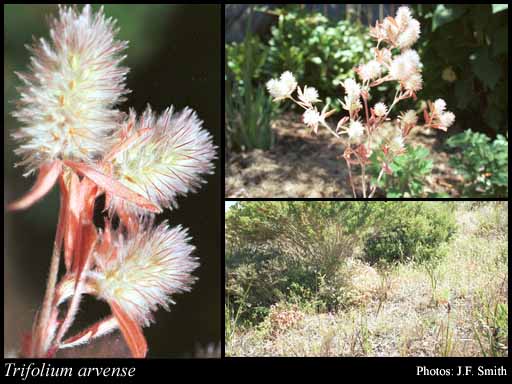- Reference
- Sp.Pl. [Linnaeus] 2:769 (1753)
- Conservation Code
- Not threatened
- Naturalised Status
- Alien to Western Australia
- Name Status
- Current
Erect or spreading annual, herb, to 0.5 m high. Fl. pink/white/green, Jun or Aug to Nov or Jan. Grey, brown or yellow sandy loam,granite. Along riverbanks, exposed rocky surfaces, agricultural areas.







Distribution
- IBRA Regions
- Avon Wheatbelt, Esperance Plains, Geraldton Sandplains, Jarrah Forest, Mallee, Swan Coastal Plain, Warren.
- IBRA Subregions
- Dandaragan Plateau, Fitzgerald, Geraldton Hills, Katanning, Lesueur Sandplain, Merredin, Northern Jarrah Forest, Perth, Recherche, Southern Jarrah Forest, Warren, Western Mallee.
- IMCRA Regions
- WA South Coast.
- Local Government Areas (LGAs)
- Albany, Armadale, Beverley, Brookton, Broomehill-Tambellup, Bunbury, Busselton, Cambridge, Coorow, Corrigin, Cuballing, Cunderdin, Dandaragan, Denmark, Dumbleyung, Esperance, Fremantle, Gingin, Gnowangerup, Goomalling, Gosnells, Greater Geraldton, Harvey, Jerramungup, Kalamunda, Kondinin, Kulin, Lake Grace, Melville, Mingenew, Moora, Murray, Narembeen, Narrogin, Northam, Northampton, Perth, Pingelly, Plantagenet, Quairading, Ravensthorpe, Serpentine-Jarrahdale, Stirling, Subiaco, Swan, Toodyay, Wagin, Wanneroo, Wickepin, Williams, Wongan-Ballidu, Woodanilling, York.
Management Notes (for the Swan NRM Region)
Alternative Names. Hares-foot Clover, Stone Clover.
General Biology. Growth form. Herb. Life form. Annual. Reproduction. Seed. Dispersal. Agricultural activities. Seedbank persistence. Short-medium term.
Notes. Found in low rainfall areas and is well adapted to low fertility soils. Its abundance varies from year to year. Has hard seed coats and low germination rates in unsuitable environmental conditions. Seed and fruit have no specialised dispersal mechanism.
Additional information. Origin. Europe, Mediterranean, north Africa, temperate Asia. History of use/introduction. Forage. Similar exotic species. Trifolium species.
Suggested method of management and control. Spot spray with 1% glyphosate before flowering, otherwise spot spray Lontrel® 3 ml/10 L (150 ml/ha) up to the 6 leaf stage. Read the manufacturers' labels and material safety data sheets before using herbicides. For further information consult the Australian Pesticides and Veterinary Medicines Authority to determine the status of permits for your situation or state.
Management Calendar
| Calendar Type | Jan | Feb | Mar | Apr | May | Jun | Jul | Aug | Sep | Oct | Nov | Dec | Comments |
|---|---|---|---|---|---|---|---|---|---|---|---|---|---|
| Germination | U | U | U | ||||||||||
| Active Growth | O | O | O | O | O | O | Y | Y | Y | Y | Y | Y | |
| Flowering | Y | Y | Y | Y | Y | Y | Y | Y | Y | ||||
| Fruiting | Y | Y | Y | Y | Y | Y | Y | ||||||
| Optimum Treatment | Y | Y | Y | O |
Legend: Y = Yes, regularly, O = Occasionally, U = Uncertain, referred by others but not confirmed.
References
- Brown, K. & Brooks, K. (2002) Bushland Weeds: A Practical Guide to their Management. Environmental Weeds Action Network, Greenwood.
- Bulinska-Radomska, Z. (2002) Reproductive biology, genetic diversity and population structure of Trifolium species. In Broad variation and precise characterization - limitation for the future. Proceedings of the XVIth EUCARPIA Genetic Resources Section workshop, Poznan, Poland, 16-20 May 2001. 2002. 156-161.
- Can, E., Celiktas, N., Hatipoglu, R. & Avci, S. (2009) Breaking seed dormancy of some annual Medicago and Trifolium species by different treatments. Turkish Journal of Field Crops, 14 (2): 72-78.
- Hackney, B., Dear, B. & Crocker, G. (2007) Primefact 651 August 2007: Naturalised pasture legumes. NSW Department of Primary Industries URL: http://www.dpi.nsw.gov.au - Accessed May 2010.
- Hussey, B.M.J., Keighery, G.J., Dodd, J., Lloyd, S.G. & Cousens, R.D. (2007) Western Weeds. A guide to the weeds of Western Australia. 2nd Edition. The Plant Protection Society of Western Australia, Victoria Park.
- Pritchard, H.W., Manger, K.R. & Prendergast, F.G. (1988) Changes in Trifolium arvense seed quality following alternating temperature treatment using liquid nitrogen. Annals of Botany, 62 (1): 1-11.
- USDA, ARS, National Genetic Resources Program (2009) Germplasm Resources Information Network - (GRIN). National Germplasm Resources Laboratory, Beltsville, Maryland. URL: https://npgsweb.ars-grin.gov/gringlobal/taxon/taxonomysimple.aspx - Accessed October 2009.